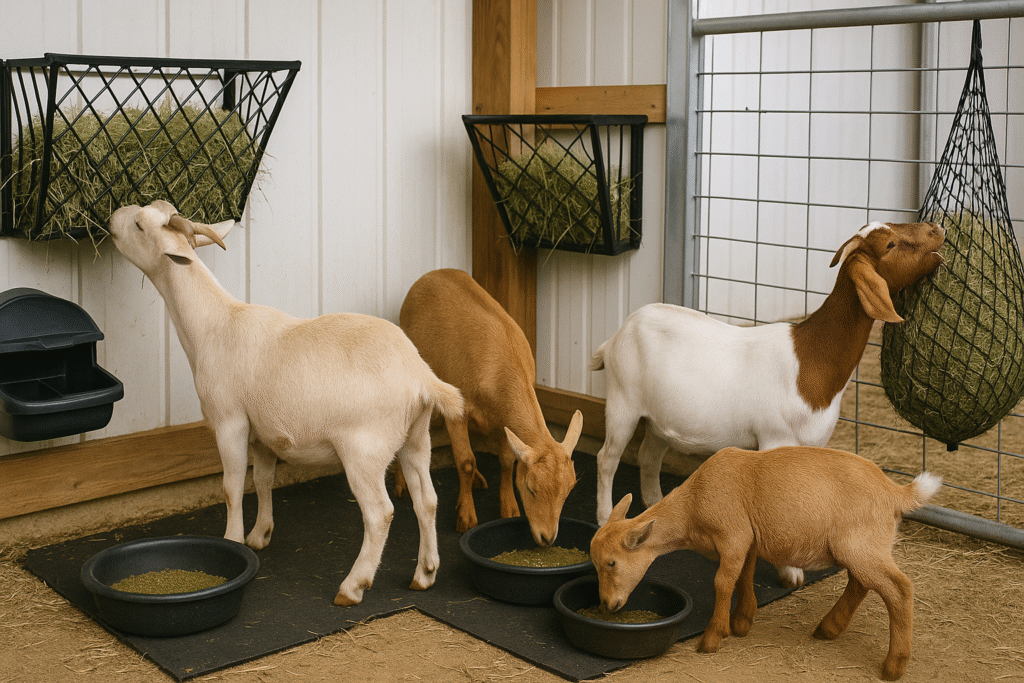
5 Best Goat Feeders in (2025): Durable, Low-Waste Picks for Town Back Yards & Country Acres
How I chose these goat feeders
A good goat feeder saves hay, speeds chores, and doesn’t turn into a toy five minutes after you hang it. For this list I prioritized:
- Low waste: designs that keep hay off the floor and grain out of the bedding.
- Goat-proofing: bar spacing, smooth edges, and hardware that survives head-butts.
- Easy cleaning: fewer crevices, fast rinse-downs, and safe materials.
- Real-world fit: models that work in small city sheds and bigger run-ins alike.
- Value: solid hardware without boutique pricing.
Affiliate Disclosure: This post contains affiliate links. If you purchase through these links, we may earn a small commission at no extra cost to you.
1 Best Overall Goat Feeder — Wall-Mount Hay Rack + Grain Combo
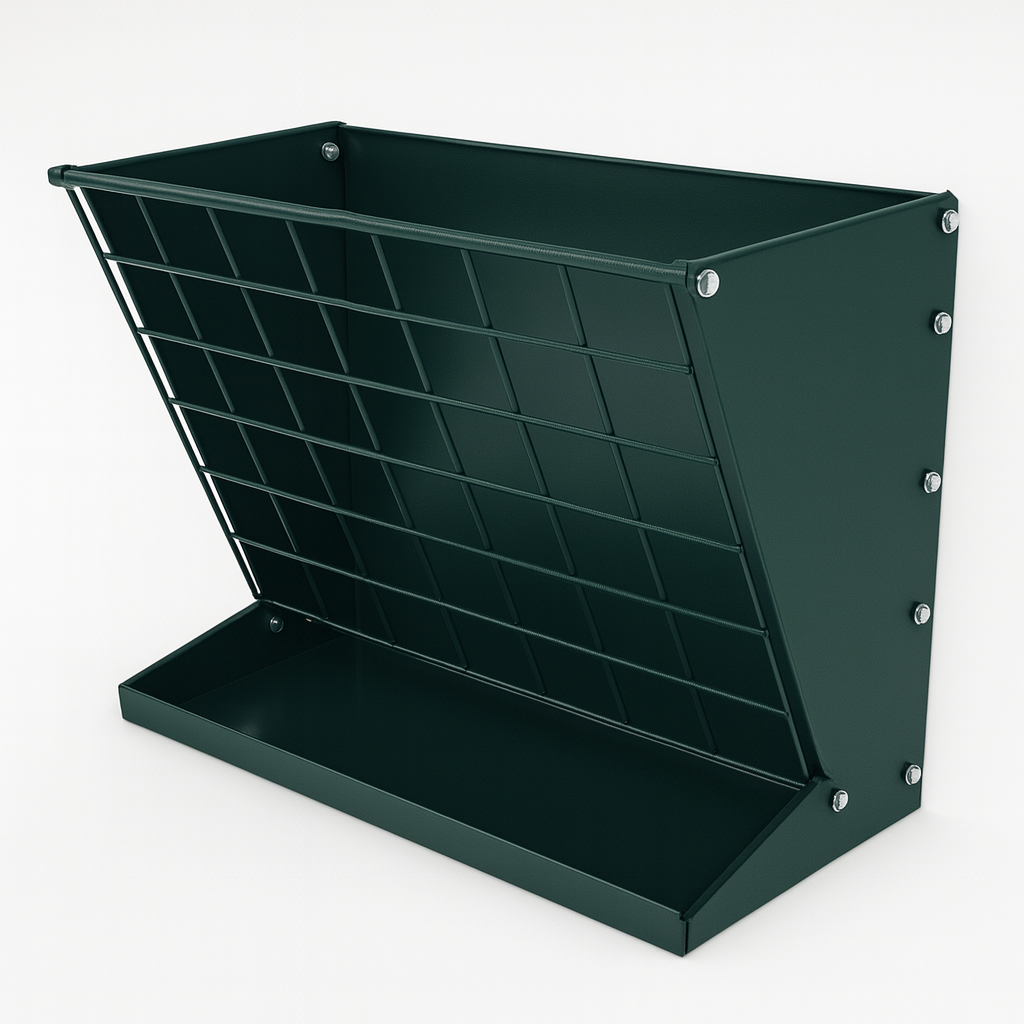
Why it wins: A wall-mount rack with an integrated bottom tray keeps long-stem hay up at muzzle height and pellets or chaff contained below. One install gives you a tidy feed station that reduces trampling and saves time.
- Powder-coated steel or heavy-gauge galvanized; no razor edges.
- Bar spacing ~3–4″ to limit face-burying and keep kids safe.
- Removable bottom pan (or a welded tray you can sweep).
Setup tips
- Mount at goat shoulder height (roughly 22–28″ for standard breeds).
- Backer board (2× lumber or plywood) spreads the load on thin shed walls.
- If bullying is an issue, install two small racks instead of one big one, and add a second exit near the feed wall.
Daily reality
- Toss hay up top; pour pellets below. Less mess, fewer nose-fuls of dust, and a cleaner threshold when it’s wet outside.
2 Best Corner Use — Corner Hay Rack with Goat-Safe Bars
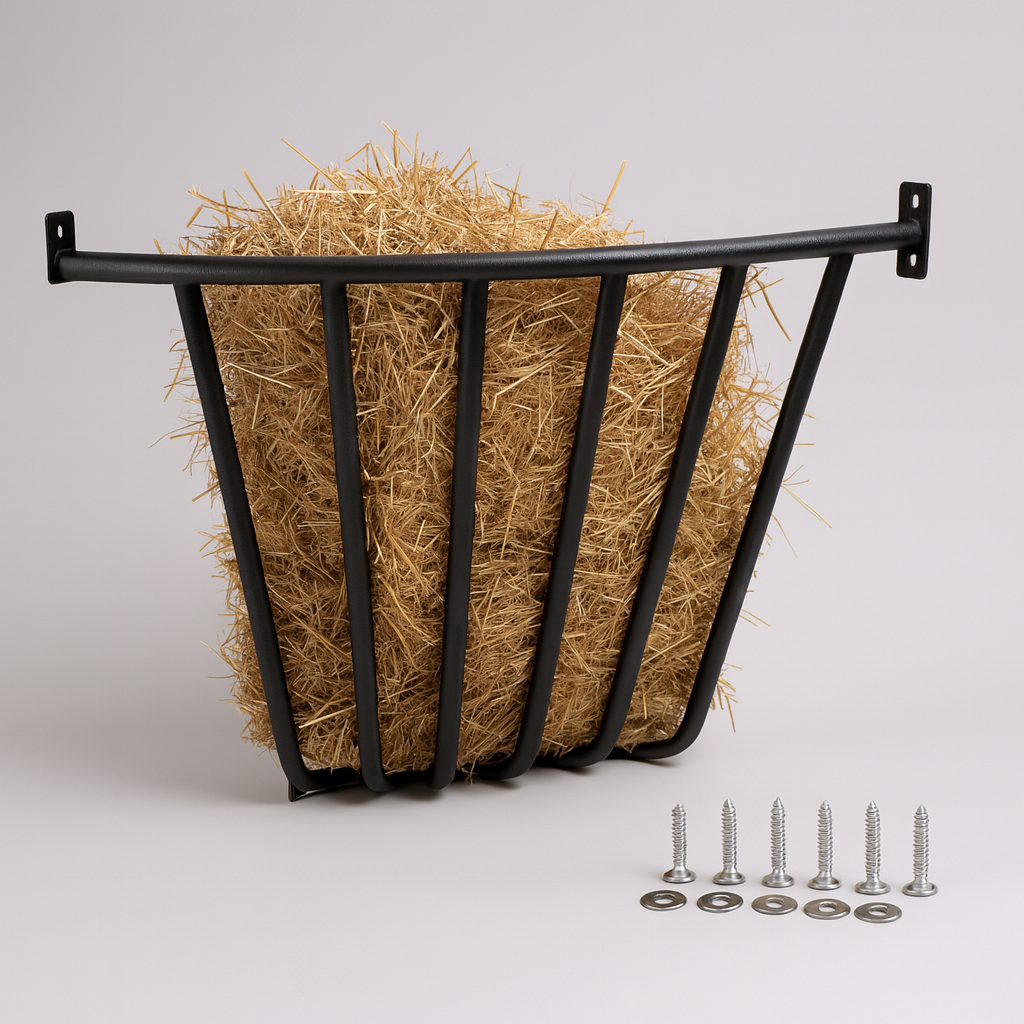
Why it’s great: Corners are dead zones—unless you drop in a welded corner hay rack. Vertical or diamond bars make it hard for goats to yank flakes out and fling them everywhere. Corner mounts also de-escalate pushing, because goats aren’t staring straight at each other across a single front.
What to look for
- Triangular frame that bolts into two studs/post faces.
- Bar geometry that blocks head-throughs but allows clean pulls.
- A catch lip or shallow tray beneath to snag fines.
Urban & rural fit
- Urban: Perfect in a 6×10 shed where wall space is tight—corners become useful.
- Rural: In a bigger run-in, put one rack at each end; traffic flows better and timid goats get a side.
Maintenance
- Scrub bars monthly; hay sap collects where faces rub.
- Once it is placed, re-tighten lag bolts; goats… are goats.
3 Best Budget Workhorse — Heavy-Duty Rubber Feed Pan
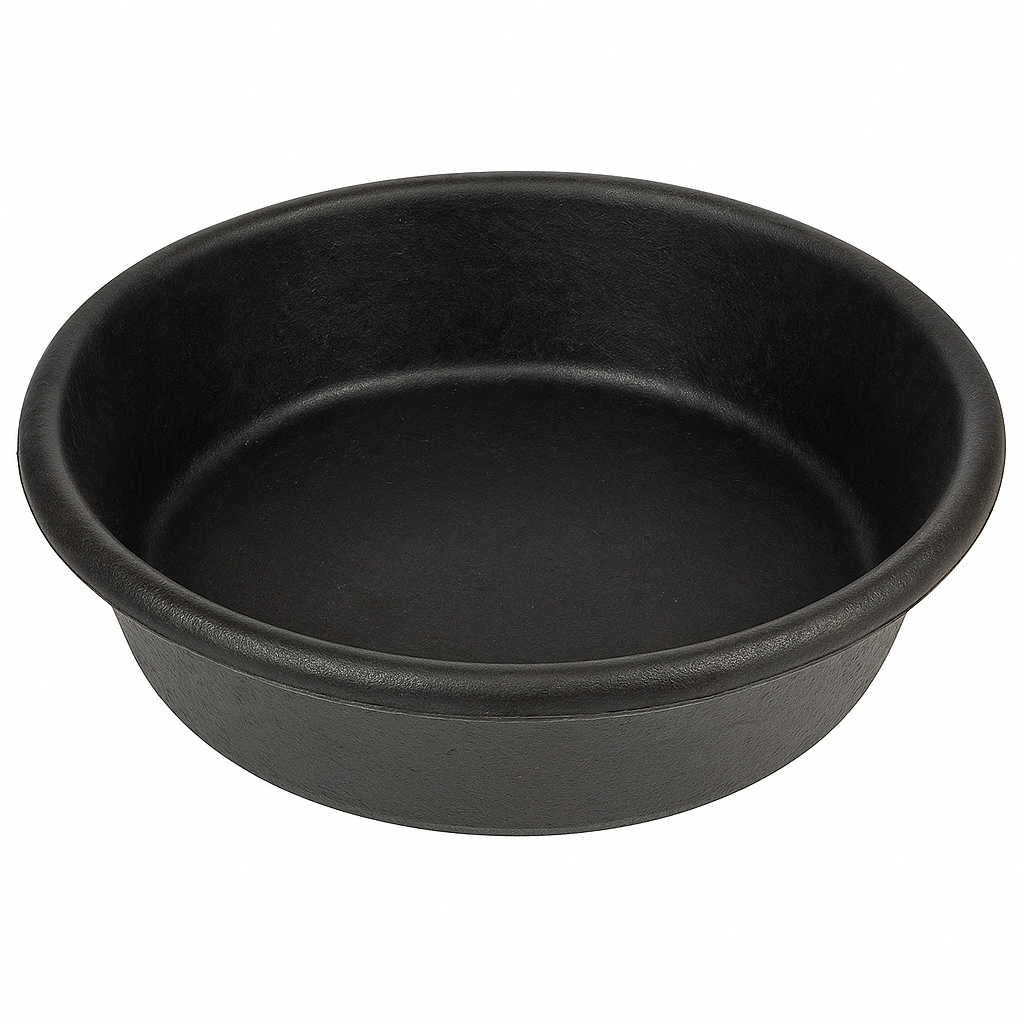
Why it belongs in every barn: These thick rubber pans are the indestructible answer for grain, beet pulp, wet mash, or electrolyte water. They tolerate kicks, freezing temps, and a winter’s worth of tossing without cracking.
What to look for
- Real vulcanized rubber, not thin plastic.
- 15–20-quart size for adult groups; 8–12 qt for kids.
- Flat bottom for stability; optional eyelet for tie-down if you feed on mats.
Use ideas
- Group grain—drop three small pans spaced out to reduce shoving.
- Soak feed—rubber stays flexible when cold; easy dump and rinse.
- Hoof soak (off-label but handy)—sturdy enough to stand in.
Care
- Quick hose and a scrub brush. If algae’s a thing, rotate pans and sun-dry.
4 Best Waste-Saver — Slow-Feed Hay Net (2″ squares, goat grade)
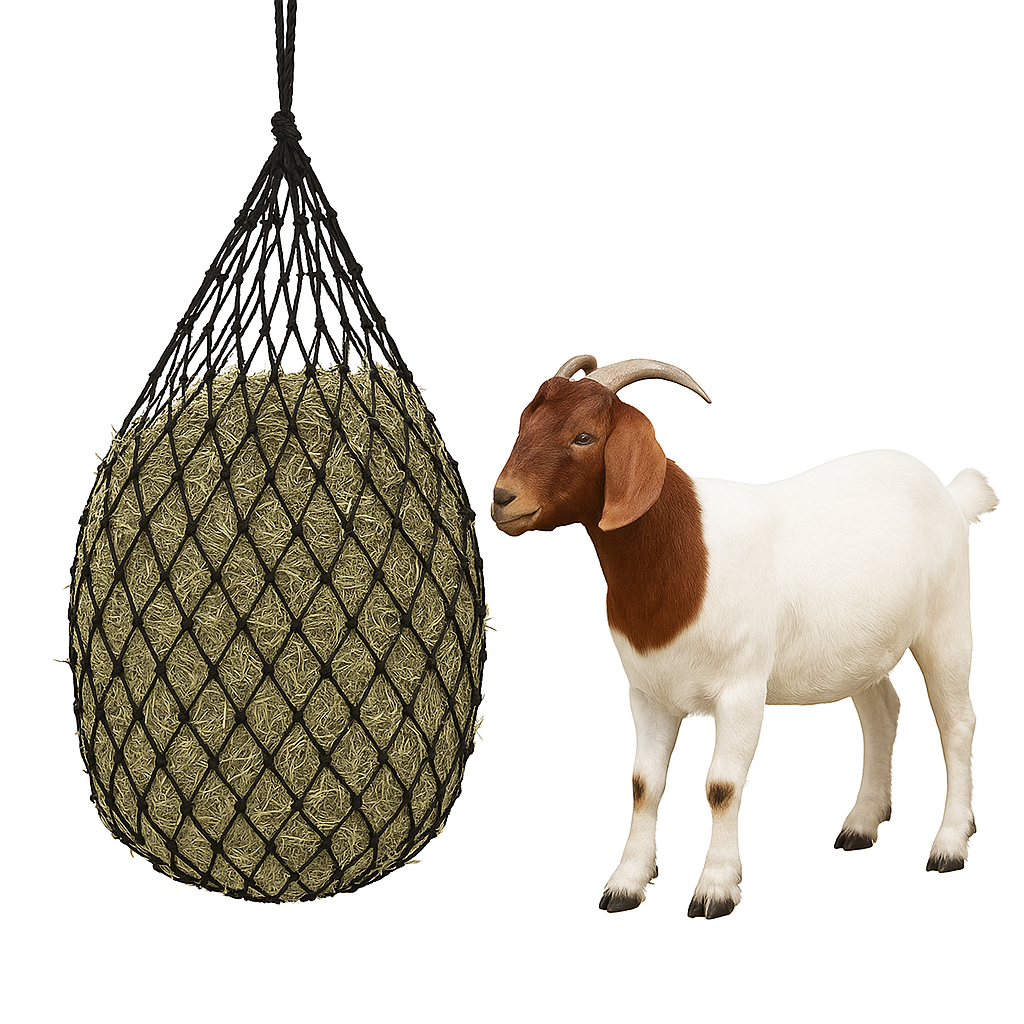
Why slow-feed works: Goats eat better—and waste less—when hay is presented through 2″ square openings. It slows the “grab, toss, trample” reflex, stretches a bale, and helps bored goats nibble steadily instead of binging.
What to look for
- Goat-grade netting (thicker cord) with reinforced rings.
- 2″ squares for general hay; 1.5″ for tiny flakes and expert nibblers.
- Metal carabiner or clip rated for livestock, not a keychain.
Mounting
- Hang outside a panel with clips, or in a stall with a breakaway tie.
- Tie the bottom so it doesn’t become a swing or hoof trap.
- In a trailer, low and tight is safer than high and swinging.
When not to use one
- Horned goats can snag in sloppy setups; use a rigid rack instead.
- Avoid extra-long nets at kid height.
5 Best for Health — Covered Mineral Feeder (Double Compartment)
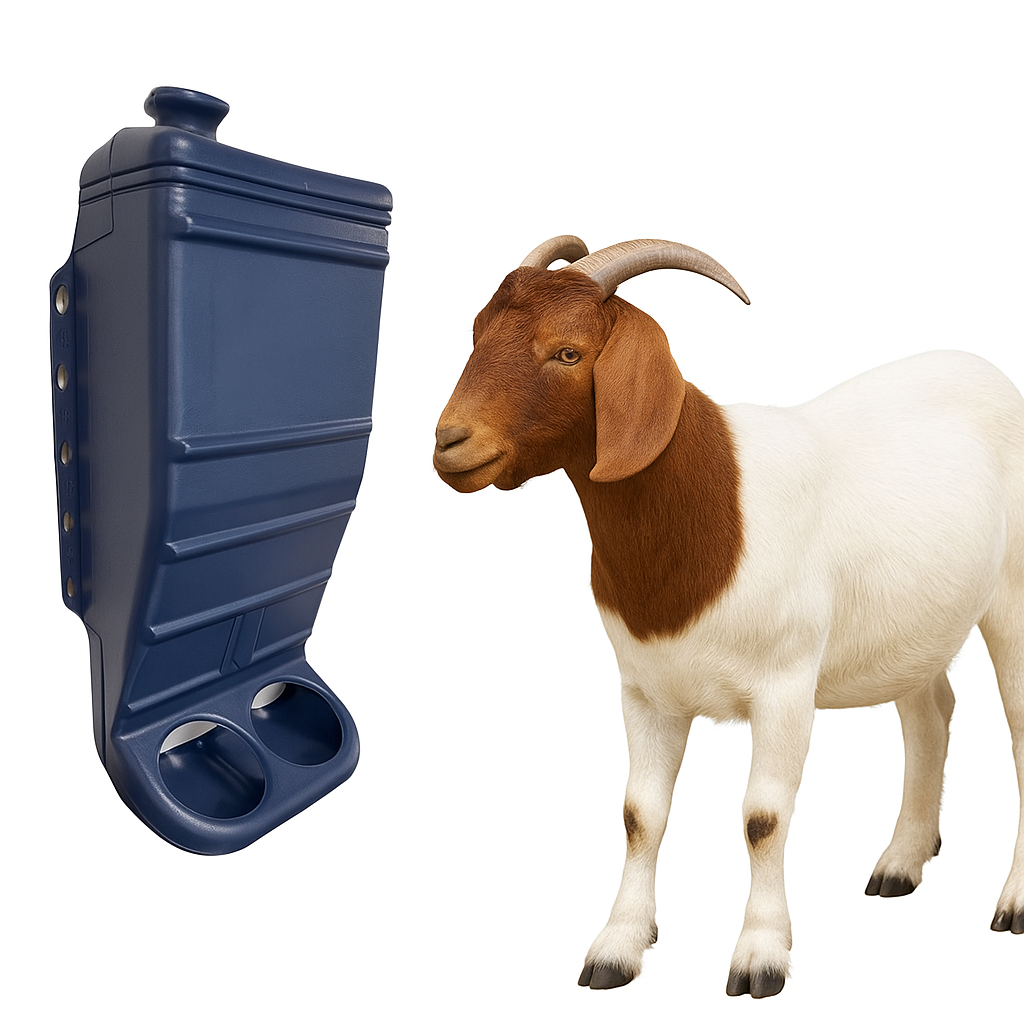
Why minerals need their own feeder: Free-choice loose minerals and buffer (baking soda if you offer it) stay potent only if they stay dry. A covered, wall-mount double compartment solves ruined minerals and licked-empty corners.
What to look for
- Flip-top or hooded lid that sheds rain.
- Separate wells for minerals and buffer.
- Smooth plastic or coated metal you can disinfect.
Placement tips
- Mount under deep roof overhang or in the shelter out of splash.
- Shoulder height for adults; add a kid station lower during kidding season.
- Keep a fresh water source nearby—minerals make goats thirsty.
Goat feeder buying guide (what actually matters)
1) Match the feeder to the feed
- Long-stem hay: wall racks or corner racks; slow-feed nets only where snag risk is controlled.
- Pellets/grain: rubber pans or a welded tray under a rack.
- Minerals: dedicated, covered feeder—never a block tied to a post.
2) Size and bar spacing
- Bar spacing around 3–4″ works for most standard breeds; smaller for Nigerians and kids.
- For horned goats, avoid anything they can wedge in; pick vertical bars or solid panels with top access.
3) Materials and finish
- Heavy-gauge coated steel lasts longest; smooth welds and rolled edges prevent scrapes.
- Rubber pans beat plastic in cold and under hooves.
- Food-safe plastics are fine for minerals; avoid brittle bins that crack in frost.
4) Mounting height & flow
- Hay at shoulder height, grain pans on rubber mats at ground level, minerals at muzzle height.
- Provide more than one feeding space—at least N+1 pans for N goats—so the boss can’t gatekeep.
5) Cleaning & disease control
- Weekly scrub prevents eye irritation from dusty hay fines and reduces parasite pressure in wet seasons.
- If coccidia is a concern for kids, keep kid-only pans clean and separate.
Urban vs. rural feeder setups
Town or City yards
- Choose wall-mount feeders that keep hay in one clean corner; add a gravel + mat pad to catch spills.
- Use smaller slow-feed nets for space-saving, but secure bottoms to avoid swinging.
- Avoid clanging hardware; neighbors notice. Rubber bumpers on gates help.
Country acres
- Consider a mobile hay station (rack on skids) plus rubber pans spaced far apart to reduce shoving.
- For rotational grazing, hang slow-feed nets on panel pens and move daily.
- Predators around? Don’t bait the fence line—keep feed stations inside the shelter so night pens stay attractive.
Daily routine that prevents 90-minute problems
- Shake-down check: Are lags tight, bars straight, lids closed?
- Hay first, grain second (if you feed grain).
- Rake the pad under the rack; remove moldy clumps.
- Rinse pans; sun-dry when you can.
- Top up minerals; if they cake, swap to a fresh, dry batch.
- Count noses. A goat skipping feed is a message—investigate.
Troubleshooting (quick fixes)
- Hay everywhere? Drop to smaller flakes; add a catch tray; switch to slow-feed on stormy weeks.
- Fights at the feeder? Provide more stations, widen the approach, and give a second exit from the feed wall.
- Nose/eye irritation? Lower dust by shaking flakes outside the shelter; clean rack rails weekly.
- Minerals ignored? Verify you’re offering a goat-specific mix, not a generic block; keep it fresh and dry.
FAQ
What’s the safest feeder for horned goats?
Rigid vertical-bar racks and corner designs with narrow spacing. Avoid rope nets unless you know your group—and always tie the bottom.
How high should I hang a hay rack?
Around shoulder height for the goats that will use it most; too high = dust in eyes, too low = trampling.
Do I need separate feeders for kids?
During the weaning/kidding season, yes. A kid creep corner with smaller pans prevents push-offs and ensures intake.
Are slow-feed nets worth it?
When used safely, they cut waste dramatically and occupy bored goats. For horned herds, a rigid rack is safer.
Quick comparison
| Pick | Best for | Why it’s great | |
| #1 Wall-Mount Hay Rack + Grain Combo | All-around daily use | One install = hay + pelleted feed in one spot; very low spill | |
| #2 Corner Hay Rack (vertical/diamond bars) | Herds with pushy eaters | Safe bar geometry; uses dead corner space; drops less on floor | |
| #3 Heavy-Duty Rubber Feed Pan (15–20 qt) | Grain & beet pulp, all seasons | Kick-proof, hose-proof, winter-proof; cheap to replace | |
| #4 Slow-Feed Hay Net (2″ squares, goat grade) | Stretching hay & travel pens | Slows intake, cuts waste; perfect with panels or in trailer | |
| #5 Covered Mineral Feeder (double compartment) | Free-choice minerals, baking soda | Weather lid; keeps minerals dry and goats healthy |
